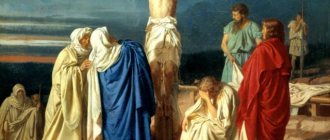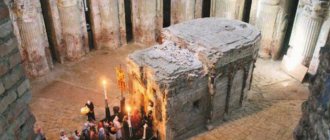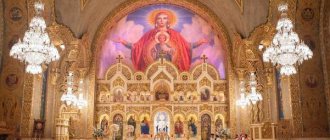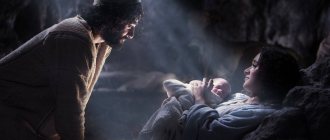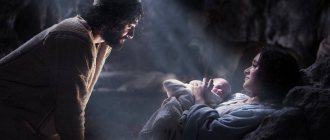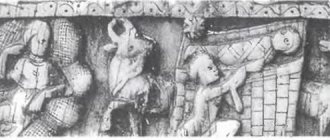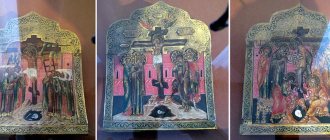In the Christian religion, the image of the cross has deep philosophical and moral significance. It became a symbol of the great atoning sacrifice made by God to deliver people from eternal death, which was a consequence of the original sin committed by our ancestors - Adam and Eve. His images are very diverse, and each has a special semantic connotation. One of them, namely the Calvary Cross, is the topic of this article.
The cross is a picture of a great event
Its outlines are familiar to everyone who has in one way or another encountered Orthodox symbols, and they can be seen on the vestments of monks, items of church utensils, as well as in attributes associated with the consecration of homes and vehicles. The Calvary Cross is a stylized picture of an event that occurred more than two thousand years ago in Palestine, which radically changed the entire course of world history.
Its composition includes images of the Cross - the instrument of torment of our Savior Jesus Christ, Mount Golgotha, on the top of which this event took place, the head of Adam resting in its depths, traditionally depicted at the foot of the Cross. In addition, this includes inscriptions that have both an explanatory and purely sacred character.
Another understanding of the word “Golgotha”
There is an expression: “everyone will ascend to Golgotha.” In the vastness of domestic countries, this expression has undergone slight changes and therefore sounds like this: “everyone carries his own cross.” Although these are two different sentences, the meaning is the same.
It must be remembered that Jesus sacrificed himself for the salvation of mankind. He preached love and mutual understanding, but his father is the ruler of heaven or God was angry with people, so we all carry our own cross in life, ascend to our own Golgotha. In this context, “Calvary” and “cross” represent problems, life’s troubles, personal suffering and other obstacles that prevent one from moving forward in life.
Many theologians interpret this judgment differently. In their opinion, those who are able to ascend to Golgotha are worthy of forgiveness and success in life. In other words, overcoming difficulties, we repeat the feat of Jesus and experience his suffering. Everyone will ascend to Calvary, because all people are God's creatures, just like Jesus himself. In recent history, the word “Golgotha” is used in other meanings, for example, to designate a place where a person has a very hard time.
Shine in the Roman sky
The center of the composition is the Cross itself. It is known that its image as a magical symbol and even as an image of a deity was found among representatives of the most ancient, pre-Christian cultures. Only in the Roman Empire did it become an instrument of shameful and painful execution, to which mainly slaves and especially dangerous criminals were subjected. His symbols appeared on the walls of the catacombs, where in the 2nd and 3rd centuries the first Christians performed secret services. They were images of a palm branch, a whip and an abbreviation of the name of Christ.
In its usual, “unencrypted form,” the Cross first appeared in the 4th century, when Christianity received the status of a state religion in Rome. According to Sacred Tradition, the Savior appeared to Emperor Constantine in a night vision and ordered him to decorate the banner under which his army was preparing to engage in battle with the enemy with the image of the Cross. In the morning, a light in the form of a cross appeared in the sky over Rome, dispelling his last doubts. Having fulfilled the command of Jesus Christ, Constantine soon defeated his enemies.
Norilsk Golgotha
Very often the term “Golgotha” is used to describe places where a person is subjected to inhuman torture or thrown into completely unsuitable conditions for life. There is a rather unpleasant page in the history of the USSR that tells about the hard labor of prisoners in places of deprivation of liberty in the Gulag system. “Norilsk Golgotha” is a fictitious name for a correctional plant located in the north of modern Russia, beyond the Arctic Circle. The place is interesting because its construction took place rapidly, and most importantly, by the hands of the very prisoners who served their sentences there. The particular mortality rate was due to the fact that prisoners worked day and night to increase production standards. This fact causes the Norilsk Mining Plant to become notorious as one of the most terrible places of detention of the NKVD system.
Three memorial crosses
The Roman historian Eusebius Pamphilus describes this banner with the image of the Cross in the form of a spear with a crossbar and the letter abbreviation of the name of Jesus Christ inscribed on top. There is no doubt that the Calvary Cross, the photo of which is presented in the article, was the result of subsequent modifications of the symbol that adorned the battle banner of the Roman emperor.
After the victory won by Constantine, as a sign of gratitude to the Savior, he ordered the installation of three memorial Crosses and the inscription “Jesus Christ the Victor” on them. In Greek it looks like this: IC.XP.NIKA. All Orthodox Calvary Crosses contain the same inscription, but in Slavic.
In 313, a great event happened: on the basis of the Edict of Milan, adopted on the initiative of Emperor Constantine, freedom of religion was established in the Roman Empire. After three centuries of persecution, Christianity finally received official state status, and its symbolism was given a powerful impetus for further development.
Four-pointed cross shape
The debate about the “correct” cross did not arise today. The debate about which cross was correct, eight-pointed or four-pointed, was waged by Orthodox and Old Believers, with the latter calling a simple four-pointed cross “the seal of the Antichrist.” Saint John of Kronstadt spoke out in defense of the four-pointed cross, devoting his candidate’s dissertation “On the Cross of Christ, in denunciation of imaginary Old Believers” to this topic.
St. John of Kronstadt explains: “The “Byzantine” four-pointed cross is in fact a “Russian” cross, since, according to Church Tradition, the holy Equal-to-the-Apostles Prince Vladimir brought from Korsun, where he was baptized, just such a cross and was the first to install it on the banks of the Dnieper in Kyiv. A similar four-pointed cross has been preserved in the Kiev St. Sophia Cathedral, carved on the marble plaque of the tomb of Prince Yaroslav the Wise, son of St. Vladimir.” But, defending the four-pointed cross, St. John concludes that both should be venerated equally, since the shape of the cross itself has no fundamental difference for believers.
Basic elements of the Cross
Despite the fact that the main Christian symbol has different designs, the Orthodox Calvary Crosses are usually depicted as three-part, that is, eight-pointed. They are a combination of a vertical post and a large crossbar, usually located at a level two-thirds of their height. This, in fact, is the very instrument of torment on which the Savior was crucified.
Above the large horizontal crossbar there is a small one parallel to it, symbolizing the tablet nailed to the cross before execution. On it were the words written by Pontius Pilate himself: “Jesus of Nazareth, King of the Jews.” These same words, but in Slavic writing, contain all Orthodox Calvary Crosses.
LiveInternetLiveInternet
I.D. Shabalina
Catalog
The group of monuments under study is based on the Cross of the Lord on Golgotha (sometimes seven-pointed along with the more common eight-pointed) - (Fig. 1, 2).
The cross is three-part: it has a large crossbar, a short one at the top, and an oblique one at the bottom. This is a canon that is carefully observed in carved reliefs. The images of the instruments of the passions are also canonical: canes and a spear, which are located vertically along the cross or extend at an angle of the base, or intersect behind the Cross (Fig. 3 - 6). The cross is cut in flat relief, at the level of other images. The cane and spear can be presented in a shortened form (Fig. 7).
Golgotha is depicted in different ways: in the form of a triangle, a semicircle, a trapezoid, a two- or three-step foot, in the form of slides (Fig. 8 - 15). The lower part of the Cross is sometimes occupied by geometric notches.
A crown or tsata can be placed in the middle cross of the Cross (Fig. 16,17).
EXPLANATIONS FOR THE CATALOG
In the catalogue, monuments depicting the Calvary Cross are grouped thematically into two sections: “Icons” and “Crosses”. The numbering adopted is uniform, continuous. Each catalog description contains: - name; — number according to the Book of Receipts, inventory number; - dimensions (indicated in cm): the first number means height, the second - width, the third - thickness; — material and manufacturing technique; — admission to the museum (purchase or gift, year of acquisition); — iconographic explanations with reproduction of inscriptions (some grammatical features of writing texts are preserved, in particular, the letter “ъ”, the “/” sign divides the text into lines); — features of carving or coloring are noted; — significant losses are indicated; — if information about monuments is incomplete, some columns of the catalog description may be omitted.
The full version is presented in the collection.
CRYPTOGRAMS
KR SL, KING OF LORD, KING OF GLORY King of Glory INCI, IN, INCI Jesus of Nazareth King of the Jews BG God IS HS, IIS HS, II X, IS HS, IS HS Jesus Christ K, KP, COPIE, COPY Copy T, TP, TRO , CANE Cane SN BZHI, SN BZHI Son of God NI KA Winner ML Place Execution RB Paradise was fast GG Mount Golgotha GA Head of Adam (Staroslav. Head of Adam) KHVV Cross - the guardian of the entire Universe KCC Cross - beauty of the church KVU Cross - the faithful statement of the KCD Cross - king power CAS Cross - angel glory KBJ Cross - demon plague KTPV We worship your cross, Lord AAK?
AAAA? BBBB God's scourge beats demons BBBBV? BBAA? ВВВВ To all the faithful, the return to paradise, to the whole universe proclaims faith. WWWWW? DDDD The tree is good, the devil is annoyed, The tree bestows ancient wealth. IVTS and Your Resurrection we glorify NVPS? 1. CROSS OF GOLGOTHA Icon. XVII century KP 13662, D 618. 17.5 x 12.6 x 2 Wood, carving. Purchased in 1889 in St. Petersburg from A. Kirillov. Rectangular, flat-relief. The fields are smooth. In the center is an eight-pointed Cross with instruments of passion: a cane and a spear. Golgotha is triangular in shape with the skull of Adam. Around the Cross there are inscriptions with the titles: / / K, T / / NI KA/ ML, RB / GG, GA.[/td]
| 2. CROSS OF GOLGOTHA Icon. Con. XVIII century KP 13060, D 523. 14.3 x 10.9 x 2.1 Wood, carving. Purchased in 1889 in St. Petersburg from A. Kirillov. Rectangular, flat-relief. The fields are smooth. In the center is an eight-pointed Cross with instruments of passion: a cane and a spear. Golgotha of stepped form with the skull of Adam. Around the Cross there are inscriptions with the titles: / / K, T / / NI KA / ML, RB / GG, GA. |
| 3. CROSS OF GOLGOTHA (AMID THE WALLS OF JERUSALEM) Icon. XVIII century KP 30260, S 142. 26 x 19.2 x 2 Wood, carving, tempera painting. Purchased in 1889 in St. Petersburg from A. Kirillov. Rectangular, flat-relief. The fields are smooth. In the center is an eight-pointed Cross with instruments of passion: a cane and a spear. Around the Cross there are inscriptions with the titles: / / K, T / NI KA / ML, GA, RB. The Wall of Jerusalem is depicted in large geometric cuts. Complete loss of paint layer. |
| 4. CROSS OF GOLGOTHA (IN A CIRCLE) Icon. XVIII century KP 30259, S 141. 33.7 x 24.6 x 1.8 Wood, carving, gesso, tempera painting. Purchased in 1889 in St. Petersburg from A. Kirillov. Rectangular, flat-relief. The fields are smooth. In the ark in a circle there is an eight-pointed Cross on Golgotha of a stepped shape. Around the circle is the text of the prayer: “WE WORSHIP THY CROSS, LORD, AND WE GLORY THY HOLY RESURRECTION.” At the top and bottom along the field of the icon is the prayer: “LET GOD AND RA RISE / THERE WILL ENJOY HIM AND...” The crucifix, the texts “INCI”, “Spear”, “Reed”, as well as the picturesque walls of Jerusalem. The letters are painted with brown paint. |
| 5. CROSS OF GOLGOTHA (IN A CIRCLE) Icon. XIX century KP 30263, C 145. 24.5 x 21.2 x 2.2 Wood, carving, tempera painting. Purchased in 1889 in St. Petersburg from A. Kirillov. Rectangular, flat-relief. The fields are smooth. In the center is a circle where the Cross is presented with the instruments of the passions: a cane and a spear. On the field of the circle there are inscriptions with the titles: / / K, T / / NI KA / ML, RB / GG, GA. To the left of the circle are the cryptograms: BBBBV / BBAA / AAK / NNN / OOP / PPPP / RRRRSS. To the right of the circle: BBBBB / DDDD / KKK / NOO / PPP / SSSS / CCXXXX. At the top and below the field of the icon is the text of an Old Believer prayer with cryptograms: “LET GOD AND DISCOVERY RISE / ENJOY HIM AND LET THOSE WHO HATER HIM FLEE FROM HIS L / FACE AS / O THE SMOKE DISAPPEARS YES THE SMOKE DISAPPEARS / UT AS THE WAX MELTS FROM THE FIRE / CA OF FIRE SO LET THE BESI PERISH ON FACE OF THOSE WHO LOVE GOD / AND THOSE WHO ARE CALLED GODFATHERS / ZDRRKGPBSNPGNIKHVSISDIK / SNRSwIKGPMSGBISNSVNI-NVVA.” The letters are covered with orange tempera. |
| 6. CROSS OF GOLGOTHA (IN A CIRCLE) Icon. Con. ХVIII - beginning. XIX centuries KP 30262, C 144. 27 x 18.2 x 2.4. Wood, carving, tempera painting. Purchased in 1889 in St. Petersburg from A. Kirillov. Rectangular, flat-relief. The fields are smooth. In the ark there is a circle with an eight-pointed Cross on Calvary in a stepped shape with a cave and the head of Adam. There are square stamps in the circle with the inscriptions: / / / / NI KA / . At the top, in relief, is the text of the prayer: “THE CROSS IS THE GUARDIAN OF THE WHOLE UNIVERSE / REST BEAUTY OF THE CHURCH CROSS...” Below: “WE BORN TO YOUR CROSS VLA / TO I THE HOLY RESURRECTION OF YOUR GLORY...” The surface of the icon is covered with brown tempera. |
| 7. CROSS OF GOLGOTHA (AMONGST INSCRIPTIONS) Icon. XVIII century KP 30261, S 143. 32.7 x 22 x 3 Wood, carving. Purchased in 1889 in St. Petersburg from A. Kirillov. Rectangular, flat-relief. The fields are smooth and narrow. The right side of the icon is missing. In the center is an eight-pointed Cross with instruments of passion: a cane and a spear. Golgotha has a stepped form. On the field of the icon, in 16 lines, the text of the prayer “May God rise again...” (in the Old Believer version) is made in relief. |
| 8. CROSS OF GOLGOTHA UNDER THE SHADOW OF THE TEMPLE Icon. XVIII century KP 30258, C 140. 30.3 x 23.7 x 3.3 Wood, carving, tempera painting. Purchased in 1889 in St. Petersburg from A. Kirillov. Rectangular, flat-relief. The fields are smooth. At the bottom of the icon is an eight-pointed Cross with instruments of the passions: a cane and a spear under the shadow of a five-domed church. Around the Cross there are cryptograms: INCI / / / K, T / / NI KA / ML, RB / GG, GA. There are cryptograms in the free space of the temple. Left: BBBB/BBBB/DDDD/NNNN. Right: WWWW/DDDD/KKKK/OOOO. At the top of the field there are icons: KHVV, KKTs, KCD, KAS / KVU, KBYA / KTPV, IVTS. White and black dots in a circle, wide and narrow colored stripes on the frame of the icon. |
| 9. CROSS OF GOLGOTHA UNDER THE SHADOW OF THE TEMPLE Icon. XVIII century KP 30257, S 139. 31.5 x 26.3 x 3.5 Wood, carving, tempera painting. Purchased in 1889 in St. Petersburg from A. Kirillov. Rectangular, flat-relief. The fields are smooth. At the bottom of the icon is an eight-pointed Cross with instruments of the passions: a cane and a spear under the shadow of a seven-domed temple. Around the cross are cryptograms: INCI / / / K, T / NI KA / ML, RB / GG, GA. In the free space of the temple there are cryptograms. Left: KTPV / BBBB / VVVV / DDDD / PPPP. Right: IVTS / VVVV / DDDD / KKKK / PPPP. Above: KHVV, KKTs, KCD, KVU/KAS, KBYA. Orange and white dots in a circle, colored letters. |
| 10. CROSS OF GOLGOTHA UNDER THE SHADOW OF THE TEMPLE Icon. XVIII century KP 30256, S 138. 33 x 25 x 3.5 Wood, carving, tempera painting. Purchased in 1889 in St. Petersburg from A. Kirillov. Rectangular, flat-relief. The fields are smooth. In the lower part there is an eight-pointed Cross with instruments of passion: a cane and a spear under the shadow of a seven-domed temple. Around the Cross there are inscriptions with the titles: INCI / / / K, T / NI KA / / ML, RB / GG, GA. Under the domes in the free space of the temple there are cryptograms. Left: KTPV / BBBB / VVVV / PPPPT. Right: IVTS / PPPPG / KKKK / PPPPE. Top: KHVV, KKTs, KCD, KAS/KVU, KBYA. White and orange dots around the circle, colored stripes around the frame, colored letters. |
| 11. CROSS OF GOLGOTHA UNDER THE SHADOW OF THE TEMPLE Icon. Con. XVIII century KP 13062, D-524. 40 x 35 x 6 Wood, carving, tempera painting. Purchased in 1889 in St. Petersburg from A. Kirillov. Rectangular, flat-relief. The fields are smooth. At the bottom of the icon is an eight-pointed Cross with instruments of passion: a cane and a spear under the shadow of a seven-domed temple. Around the Cross there are cryptograms: / / K, T / / NI KA / ML, RB / GG, GA. Under the domes in the free space of the temple there are cryptograms. Left: KTPV / BBBB / VVVV / PPPPT. Right: IVTS / VVVV / KKKK / PPPPE. Top: KHVV, KKTs, KCD, KAS/KVU, KBYA. White, black and red dots in a circle, wide and narrow stripes around the frame of the icon. |
| 12. CROSS OF GOLGOTHA 19th century. KP 9378, D 136. 18.2 x 12.5 x 2.7 Wood, carving. Purchased in 1891 from M.V. Semenov. Four-pointed, flat-relief. The fields are smooth. In the center is a seven-pointed Cross with instruments of passion: a cane and a spear. Golgotha is triangular in shape with the skull of Adam. On the branches of the Cross there are relief inscriptions with the titles: / INCI / / COPY, TRw / ML, RB. |
| 13. CROSS OF GOLGOTHA 19th century. KP 9778, D 205. 5.2 x 2.2 x 1 Wood, carving. Purchased in 1910 in Rostov from A.A. Well done. Four-pointed, flat-relief. Double-sided. The fields are smooth. On the front side there is an eight-pointed Cross with instruments of passion: a cane and a spear. Golgotha with Adam's skull. On the branches of the Cross there are inscriptions with the titles: / / K, T / / NI KA, GA. On the reverse side of the cross there is the inscription: “YES V / OSK / RESNET / Kommersant BGЪ.I RAZEDUT / SYA V / RAZ / AND EG / O AND B.” Has an eyelet for hanging. |
| 14. CROSS OF GOLGOTHA 19th century. KP 11974, D 385. 21.3 x 10 x 1.7 Wood, carving. Purchased in 1889 in St. Petersburg from A. Kirillov. Four-pointed, flat-relief, with extended upper and lower branches. The fields are smooth. In the center is an eight-pointed Cross with instruments of passion: a cane and a spear. Golgotha is semicircular in shape. On the branches of the cross there are inscriptions with the titles: / / K, T / NI KA / ML, GG. On the back, in the middle of the cross, there is the inscription: CROSS. |
| 15. CROSS OF GOLGOTHA XVII century. KP 12003, D 404. 21.3 x 11.8 x 2.7 Wood, carving. Purchased in 1898 in Rostov from V. M. Seleznev. Four-pointed, flat-relief, with extended upper and lower branches. The fields are smooth. In the center is an eight-pointed Cross with instruments of passion: a cane and a spear. Golgotha is semicircular in shape with the skull of Adam. On the branches of the Cross there are relief inscriptions with the titles: / / / , /,. |
| 16. CROSS OF GOLGOTHA 19th century. KP 9748, D 190. 7 x 4.2 x 1.2 Wood, carving. Purchased in 1889 in St. Petersburg from A. Kirillov. Four-pointed, medium relief, with slightly widened upper and lower branches. Double-sided. On the front side, on the margins, there is a “runner” design in relief. In the center is an eight-pointed Cross with intersecting instruments of passion: a cane and a spear. Golgotha is depicted as a pile of stones. In the upper branch of the cross there is a triangle with rays emanating from the lower side and the inscription: BГЪ. On the side branches there are inscriptions with titles: / NI KA. On the reverse side the margins are smooth. In the center is a heart with the monogram of the Mother of God. In the upper branch of the cross there is a chalice in relief, and in the lower branch there is a coffin. Rays emanate from them. Above the coffin there is a hammer and tongs. In the left branch of the cross there is a pillar, in the right there is a ladder. Has an eyelet for hanging. |
| 17. CROSS OF GOLGOTHA XVIII century. KP 9395, D 142. 30.7 x 14.5 x 2 Wood, carving, gesso, gilding, tempera. Gift of Sokolov (initials unknown). Entered the museum in 1886. Four-pointed, flat-relief. The right branch of the cross is lost. The fields are smooth. In the center is an eight-pointed Golgotha Cross of a semicircular shape. Below in the square recess there is the inscription: “AFA CROSS / TSAREM DER / UZHAVA KR / ST VERNY / M AFTER...” Gilded, on the field of the cross there are picturesque images of the Crucifixion and saints, darkened by time. Has a ring for hanging. |
| 18. CROSS OF GOLGOTHA Con. XIX century KP 9750, D 192. 15.5 x 5.4 x 1.5 Wood, carving Purchased in 1891 from M.V. Semenov. Eight-pointed, flat-relief. The fields are smooth. In the center is a seven-pointed Cross with instruments of passion: a cane and a spear. Golgotha is triangular in shape with the skull of Adam. On the branches of the cross there are inscriptions with the titles: / / / K, T / NI KA / ML, RB. The cryptograms on the left branch of the cross are not cut out. Has an eyelet for hanging. |
| 19. CROSS OF GOLGOTHA XVIII - XIX centuries. KP 12139, D 442. 20.5 x 10.5 x 1.5 Wood (pine), carving. Purchased on March 18, 1926 in Moscow from S. M. Popov. Belonged to the collection of B.N. Edinga. Eight-pointed, flat-relief, with a slightly widened lower branch. The fields are smooth. In the upper branch of the cross, teeth and a “runner” pattern are made using a chisel. In the center is a seven-pointed Cross. Under the main crossbar are shortened images of instruments of passion: canes and a spear. Golgotha is semicircular in shape with the skull of Adam. The free fields are filled with inscriptions with titles: / / NI KA / KPOETR / OTY ML / RB AG. Has a ring for hanging. |
| 20. CROSS OF GOLGOTHA 19th century. KP 11975, D 386. 18.2 x 8.7 x 1.1 Wood, carving. Purchased in 1897 from Vasily Stepanovich Zakharov. Four-pointed, flat-relief. The right branch of the cross is lost. The fields are smooth. In the center is a seven-pointed Cross with instruments of passion: a cane and a spear. Golgotha is triangular in shape. There is a crown on the Cross. On the field of the cross there are relief inscriptions with the titles: / / / NI / ML, RB. The Jerusalem Wall is depicted in geometric cuts. |
| 21. CROSS OF GOLGOTHA XVI - XIX centuries. KP 11972, D 383. 32.6 x 13 x 2 Wood, carving. Purchased on March 18, 1926 in Moscow from S.M. Popova. Belonged to the collection of Boris Nikolaevich Eding. Four-pointed, flat-relief, with extended upper and lower branches. The fields are smooth. In the center is a seven-pointed Cross with instruments of passion: a cane and a spear. On the Cross - tsata. On the branches of the cross there are inscriptions with the titles: / CROSS BESO / MЪ ULCER / / NI KA / ML GG. The Jerusalem Wall is depicted in geometric cuts. |
| 22. CROSS OF GOLGOTHA 19th century. KP 12141, D 440. 16.5 x 8 x 1.7 Wood (linden), carving. Purchased in 1898 in Rostov from V. M. Seleznev. Eight-pointed, flat-relief. The fields are smooth. In the center is an eight-pointed Cross with instruments of passion: a cane and a spear. The calvary is triangular in shape with geometric recesses. There is a crown on the Cross. On the branches of the cross there are relief inscriptions with the titles: / / / NI KA / ML, RB. |
| 23. CROSS OF GOLGOTHA XVIII century. KP 12138, D 444. 16.5 x 10 x 2.5 Wood (cypress), carving, tempera painting. The year of admission is unknown. Gift of V. N. Kiselev. Four-pointed, in medium relief, with a rectangular top. The ends of the lateral and lower branches have a bow-shaped appearance. In the middle cross there is an eight-pointed Cross with instruments of passion: a cane and a spear. Golgotha is rectangular in shape. Around the Cross there are cryptograms: ISЪ HSЪ / ML / RB / GA. Along the vertical crossbar of the Cross there are relief inscriptions made in a mirror image: CANE / COPIE. On the branches of the cross, a troparion for the Feast of the Exaltation of the Cross is made in relief. The text is placed in three-tiered deep icon cases separated by an ornamented runner. On the upper branch of the cross: IN / TsR S / LAVA / CROSS / YOUR WORSHIP / WORSHIP / WE ARE VLA / DYKO AND S / HOLY V / SKRESENI / E YOUR SL; on the left branch of the cross: VIMI SP / SIGOSP / DI PEOPLE S / VOYA AND BLA / GOSLOV / DOSTOYA; on the right branch of the cross: NIE SVOLO / TROUBLES BLAH / GOVERNOR / MU KRYU ON / SHAM US / AGAINST; on the lower branch of the cross: I GIVE AND MYSELF / I KEEP / I CROSS LOVE…. The field of the cross is painted with brownish-red tempera. |
| 24. CROSS OF GOLGOTHA 19th century. KP 12001, D 402. 19.3 x 9 x 1.5 Wood, carving. Purchased in 1889 in St. Petersburg from A. Kirillov. Eight-pointed, flat-relief. The fields are smooth. In the center is an eight-pointed Cross with instruments of passion: a cane and a spear. Golgotha in the form of a trapezoid with geometric patterns. There is a crown on the Cross. On the branches of the cross there are inscriptions with titles: / / / , . Part of the relief on the left has been erased. |
Symbolic measure of sinfulness
At the bottom of the vertical column there is a small inclined crossbar - a symbolic foot, strengthened after the Savior was nailed to the Cross. The Calvary Cross, like all Orthodox crosses in general, is depicted with a crossbar, the right edge of which is higher than the left.
This tradition goes back to the biblical text, which tells that two thieves were crucified on both sides of the Savior, the one on the right repented and gained eternal life, and the one on the left blasphemed the Lord and doomed himself to eternal death. Thus, the inclined crossbar plays the role of a symbolic measure of human sinfulness.
National crosses: from Africa to the Basque Country
While in the first centuries of our era crosses or their prototypes occasionally appeared on frescoes in catacombs, sarcophagi, mosaics and some coins or gilded ends, in late Antiquity they became part of the liturgy and an integral - and most important - part of Christian iconography. It is not surprising that a huge number of forms of the cross arose. The very first of them were:
crux quadrata
, or Greek cross;
crux immissa
, or Latin cross;
Variations of it include the inverted cross of St. Peter, as well as the archiepiscopal cross—and the papal cross—used in Catholic liturgy. The papal cross, triple, like the papal tiara, is a symbol of the Trinity and distinguishes the pope from other clergy. Accordingly, the archiepiscopal cross demonstrates that the archbishop is one step lower in rank.
crux commissa
, or Tau cross;
crux decussata
, or St. Andrew's Cross.
Most theologians believed that Christ was crucified on a Latin cross, although some suggested that it was still a Tau cross. The diversity of opinions is also evidenced by various assumptions that the Savior was hanged and not crucified on the cross. For example, in the hymn of Venantius Fortunatus “The Banners Are Coming to the King” (VI century), when describing the crucifixion of Christ, instead of the word “crucified” there is the word “suspended”:
The banners are approaching the king, And there the mystery of the Cross will shine, Where in the flesh the one who created us was suspended by our enemies.
The four main forms of the cross were used in liturgy, church decoration and heraldry. Due to the active use of the symbol throughout Christendom, many artists tried to create more and more intricate forms, thus distinguishing their crosses from others.
So the cross acquired countless “national” variants. In the 3rd century, among the Copts living in the territory of modern Egypt, a cross, going back in shape to the ancient Egyptian ankh, spread.
In Armenia, the first country to adopt Christianity (301), the cross became a figurative cross.
It was with such decorations along the edges that sculptors depicted the crucifix on stone khachkar crosses. They probably meant living leaves sprouting from the dead tree of the cross, hinting at the resurrection of the Savior. In Georgia, Christianity was adopted in 326; according to legend, Saint Nina convinced the king to baptize the country. The Georgian variation of the cross is associated with the legend that the Mother of God appeared to St. Nina and handed her a cross woven from a grapevine.
This explains its unusual shape and at the same time makes it similar to the Armenian cross with pronounced plant motifs. In Caucasian Albania, neighboring Armenia, where Udin Christians lived (in this country they adopted Christianity after Armenia - in the 330s), the cross was also similar to the Armenian one.
On modern Udi crucifixes there are also symbols of the Moon and the Sun (often present on Orthodox icons or Catholic altar panels).
The second wave of baptisms in European countries gave rise to new “national” forms of the cross. In the early Middle Ages, in the 8th–9th centuries, the Celtic cross, that is, a crucifix enclosed in a circle, spread among the Celtic peoples (baptized in the 5th century) and in Britain (Christianization in the 7th century).
There are several theories about the origin of the Celtic cross shape. Some scholars believe that this is an image of wooden supports that supported the crossbar.
Others are inclined to believe that the Celtic cross is just a variation of the ring crosses common throughout Christendom, and the ring in it symbolizes the celestial sphere. Similar crosses with “halos” were found in other countries - France, Russia (Novgorod), Galicia, etc. - however, they did not become common symbols there.
Its cross appeared in North Macedonia in the 11th century.
This original form is borrowed from national ornaments that previously appeared in church books, temple decorations, etc. It is largely rooted in folk tradition and associated with natural forms. In the 13th century, a unique form of the cross appeared in neighboring Serbia.
The cross of Saint Sava, which is an equilateral Greek crucifix, is decorated with four flints stylized as C-shaped symbols. This pattern is borrowed from the Byzantine cross of the 6th century, in which instead of the letters C there were the letters B, referring to the phrase “The king (basileus) of kings reigns over kings.” In the Serbian version, it turned into “Saint Sava - Serbian glory.”
A new surge in fashion for crosses of various shapes arose during the Crusades, when Christian symbolism began to merge with the early heraldic tradition. The Crucifixion of the Crusaders, which appeared in the 11th century, after the capture of Jerusalem, consisted of four small crosses located around the main, Greek equilateral cross.
It was believed that the central cross symbolized Christ, and those located on the edges symbolized the four evangelists; or five crosses designated the five wounds of the Savior - in the legs, arms and side; There was also an interpretation of small crosses as nails placed around a crucifix. In the 13th century, this cross became the official symbol of the Kingdom of Jerusalem.
Galician knights in the 12th century founded the Grand Military Order of the Sword of St. James of Compostela and used the cross-sword as an emblem, referencing the execution of the Apostle James, as well as their intention to expel Muslims from the Holy Land by fire and sword.
The Knights Templar in the 12th century could use the claw cross, which appeared in the early Middle Ages.
It was depicted on the Templar uniform and was always bright red, demonstrating the Templars' desire to be martyred for their faith. In the 14th century, the Order of Malta began to use a cross of a similar shape, with four sharp corners at the ends, reminiscent of arrowheads.
The eight-pointed Maltese cross symbolized, according to one version, eight langs
Knights Hospitaller, that is, the eight nationalities participating in the order. In another interpretation, the eight ends represent the eight beatitudes from the Sermon on the Mount of Jesus Christ.
Many peoples who were baptized at the dawn of Christianity did not have their own “national” crosses for a long time, but in the late Middle Ages and in modern times, during the era of the rapid formation of national identities, they began to use traditional motifs to create crucifixes of national significance. In 333, Christianity was adopted by the kingdom of Aksum, the core of which was located in the territory of today's Ethiopia.
By at least the 13th century, intricately shaped crosses had appeared in Ethiopia, with a massive base called the “hand of Adam” and a massive arch on top, decorated with twelve rays.
This element on the so-called Lalibela cross is interpreted as the twelve apostles surrounding Christ.
There are three main styles of crosses in Ethiopia today, related to the regions of manufacture. In addition to the cross of Lalibela, there are crosses of Gondar and Aksum, which, since the 14th century, have been developing ornamental geometric motifs with many interlaces, knots and repeating patterns. Such crosses have square, rhombic or round halos or blades.
On the territory of the modern region of Spain, in the Basque Country, in the 16th century, a special image of the Basque cross originated, dating back to prehistoric ornaments. The four petals, rotating clockwise, resemble both a cross and the Sun in shape.
This sign, called lauburu
, becomes a symbol of national liberation, and many Basques believe that its four petals represent the four provinces of their country.
Symbol of the Place of Execution
The Calvary Cross is always depicted on a certain pedestal, personifying Mount Calvary, the name of which is translated from Hebrew as “skull”. This served as the basis for another name mentioned in the Slavic and Russian translations of the Gospel - “The Place of the Execution”. It is known that in ancient times it served as a place of execution of especially dangerous criminals. There is evidence that the mountain, consisting of gray limestone, actually resembled a skull in appearance.
As a rule, Golgotha is depicted in several versions. It can be a hemisphere, or a pyramid with smooth or stepped edges. In the latter case, these steps are called “steps of spiritual ascent,” and each of them has a specific name: the lower one is Faith, the middle one is Love, the highest one is Charity. On both sides of the mountain on which the Calvary Cross is depicted are placed two letters - “GG”, which means “Mount Golgotha”. Their outline is mandatory.
Historical location of the place
If we talk about Golgotha as the “place of execution” where Jesus Christ met his fate, then it must have real geographical coordinates. Considering the traditions of the 1st century AD then reigning in Jerusalem, Golgotha was located outside the city walls. This was done in order not to desecrate the sacred borders of the city with an unholy act (execution). Therefore, in the 1st century, Golgotha was located northwest of the city. Nowadays, the Church of the Holy Sepulcher is located on this site, located in the area of the old quarter of Jerusalem.
At the moment, this is, in fact, an ordinary building in which three Christian shrines are located: the Holy Sepulcher, Golgotha, and the Slab of Anointing. There are other versions of the historical location of Golgotha. Some scholars are confident that this place was located in the north of Jerusalem in close proximity to the Damascus Gate. There is a legend that Golgotha is the burial place of Adam himself, but no evidence has been found to support this.
Cane, spear and skull
In addition to all of the above, the Calvary Cross, the meaning of which, first of all, is the personification of sacrifice and redemption of humanity through the suffering of Christ, as a rule, is depicted with the attributes of executioners mentioned in the Gospel. This is a cane, at the end of which there is a sponge with vinegar, and a spear that pierced the body of the Savior. They are usually marked with the corresponding letters - “T” and “K”.
The skull depicted inside Golgotha also occupies an important place in the overall composition. This is the symbolic head of our progenitor Adam, as evidenced by the letters “G” and “A” inscribed next to it. It is generally accepted that the sacrificial blood of Christ, penetrating through the thickness of the mountain, washed it from original sin. There are several versions about how Adam's head ended up in the depths of this mountain. One of them claims that the body of the progenitor was brought here by angels, according to another, he was buried here by Adam’s descendant Seth, and according to the most common version, the body was brought by the waters of the Flood.
Other inscriptions
According to established tradition, there are other symbolic designs accompanying the Calvary Cross. The meaning of the inscriptions (always done in Slavic) is fully consistent with the Gospel story about the passion of the Lord. At the top of the cross is usually written “Son of God.” In some cases, it is replaced by the inscription “King of Glory”. Above the large horizontal crossbar is the inscription “IC XP” - “Jesus Christ”, and below, as already mentioned, “NIKA” - “Victory”. The place of the event and its main result are indicated by the letters “ML” - “Place of Execution”, and “RB” - “Paradise to Be”.
A Piece of God's Grace
A schematic representation of the site of Christ's crucifixion - the Calvary Cross, body cross, pectoral cross and altar cross - has firmly become one of the most revered Orthodox symbols. Nowadays, it is not only an attribute of monastic asceticism, but also a shrine carefully preserved by pious laity.
Most Russians, sometimes even those who do not consider themselves believers, nevertheless adhere to ancient traditions and wear symbols of Christianity on their chests, including the Calvary Cross. Whether silver was used to make it, gold, or it is made of other metals, consecrated in the Church of Christ, it always carries within itself a particle of Divine Grace, so necessary in the life of each of us.
Consecration of the pectoral cross
Another very important issue is the consecration of the pectoral cross. If a cross is purchased at a temple shop, then it is usually consecrated. If the cross was purchased elsewhere or has an unknown origin, then it must be taken to the church, ask one of the temple servants or the worker behind the candle box to transfer the cross to the altar. After examining the cross and if it complies with Orthodox canons, the priest will serve the rite prescribed in this case. Usually the priest blesses the crosses during the morning prayer service. If we are talking about a baptismal cross for a baby, then consecration is possible during the Sacrament of Baptism itself.
When consecrating the cross, the priest reads two special prayers in which he asks the Lord God to pour heavenly power into the cross and that this cross will protect not only the soul, but also the body from all enemies, sorcerers and all evil forces. That is why many pectoral crosses have the inscription “Save and Preserve!”
In conclusion, I would like to note that the Cross must be revered with its correct, Orthodox attitude towards it. This is not just a symbol, an attribute of faith, but also an effective protection of a Christian from satanic forces. The cross must be honored both by actions, and by one’s humility, and by imitation of the Savior’s feat, as far as possible for a limited person. The rite of monastic tonsure says that a monk must always have the suffering of Christ before his eyes - nothing makes a person gather himself, nothing so clearly shows the need for humility as this saving memory. It would be good for us to strive for this. It is then that the grace of God will actually act in us through the image of the sign of the cross. If we do it with faith, we will truly feel God's power and know God's wisdom.
Material prepared by Ignatova Natalya
